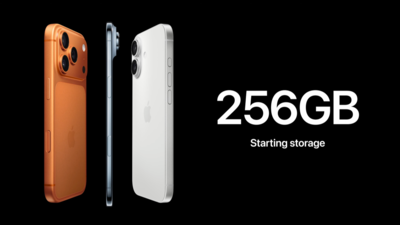ARTICLE AD BOX

Apple launched its latest iPhone lineup, which includes four models. This includes three new iPhone 17 models: iPhone 17, iPhone 17 Pro and iPhone 17 Pro Max, along with the slimmest ever iPhone Air model. Now, all the latest iPhone models have a ProMotion display and 48MP Fusion wide cameras. All the models now start with 256GB of storage, while the front gets an 18MP camera with Centre Stage support, which was introduced with iPad last year. The base iPhone 17 model comes powered by Apple’s A19 chipset, while the Air and the Pro models feature A19 Pro chipsets. The Cupertino-based tech giant has announced the prices, availability, pre-order details and sale dates of each model in India. Here are all the details:
iPhone 17 and Air models: India pricing, pre-order and other details
| Models | Starting price | Pre-order date | Sale date |
| iPhone 17 | Rs 82,900 | September 12 | September 26 |
| iPhone 17 Pro | Rs 1,34,900 | September 12 | September 26 |
| iPhone 17 Pro Max | Rs 1,49,900 | September 12 | September 26 |
| iPhone Air | Rs 1,19,900 | September 12 | September 26 |
Apple reduced the India pricing of the iPhone 17 base model. Last year’s iPhone 16 base model started at Rs 79,990 for 128GB storage. However, this year’s iPhone 17 begins at Rs 82,990 and starts with 256GB storage. A new addition this year is the iPhone Air, priced at Rs 1,19,900, which effectively replaces the Plus model, previously priced at Rs 89,900. This is the same starting price for the iPhone 16 Pro model’s 128GB storage variant.
Meanwhile, Apple has increased the prices of the iPhone 17 Pro models by Rs 5,000. The 256GB variants of the iPhone 16 Pro and iPhone 16 Pro Max started at Rs 1,29,900 and Rs 1,44,990, respectively. Now, the same storage variants of iPhone 17 Pro and Pro Max models are Rs 1,34,990 and 1,49,990, respectively. Pre-orders for the iPhone 17 series and iPhone Air is set to begin on September 12, with sales starting September 26, while last year’s iPhone 16 lineup followed an earlier window of September 13 pre-orders and September 20 sales.
iPhone 17 series and iPhone Air: Key highlights
The iPhone 17 series and the new iPhone Air introduce some of the biggest design, performance, and durability changes Apple has made in recent years. The iPhone Air is the thinnest and lightest iPhone ever at just 5.6mm, built with a strong titanium frame and a new “plateau” design for cameras and components. It features a 6.5-inch Super Retina XDR display with 120Hz ProMotion, record-high 3000 nits brightness, and Ceramic Shield 2 protection on both front and back for 3–4x better scratch and crack resistance.Its camera setup includes a new 18MP square Centre Stage front camera that works in both portrait and landscape, plus a 48MP Fusion central system with telephoto options. The phone is powered by the A19 Pro chip, which also powers the iPhone 17 Pro and Pro Max models, alongside new Apple-designed N1 (Wi-Fi 7, Bluetooth 6) and C1X (cellular) chips, offering the most efficient performance and longer all-day battery life. It also introduces eSIM-only design, improved AI-powered photography, and Apple Intelligence in iOS 26.The iPhone 17 lineup focuses on a sleeker design with thinner borders, 6.3-inch ProMotion displays with the same 3000 nits brightness, and upgraded Ceramic Shield 2 durability. For the first time, all rear cameras are 48MP Fusion sensors, including wide and ultra-wide, paired with the new 18MP Center Stage front camera. The A19 chip (not Pro) still delivers a huge performance boost with better GPU and AI acceleration, supporting features like next-gen Photographic Styles and 30 hours of video playback. Like the Air, it also benefits from the N1 wireless chip and iOS 26’s Apple Intelligence features.Meanwhile, the iPhone 17 Pro and Pro Max feature a new aluminium unibody with vapour chamber cooling, larger batteries, and the A19 Pro chip for 40% better sustained performance. Highlights include brighter Ceramic Shield 2 displays, advanced 48MP cameras with up to 8x zoom, an 18MP Center Stage front camera, and pro-grade video recording.



.png)
.png)
.png)
















 4 hours ago
4
4 hours ago
4







 English (US) ·
English (US) ·